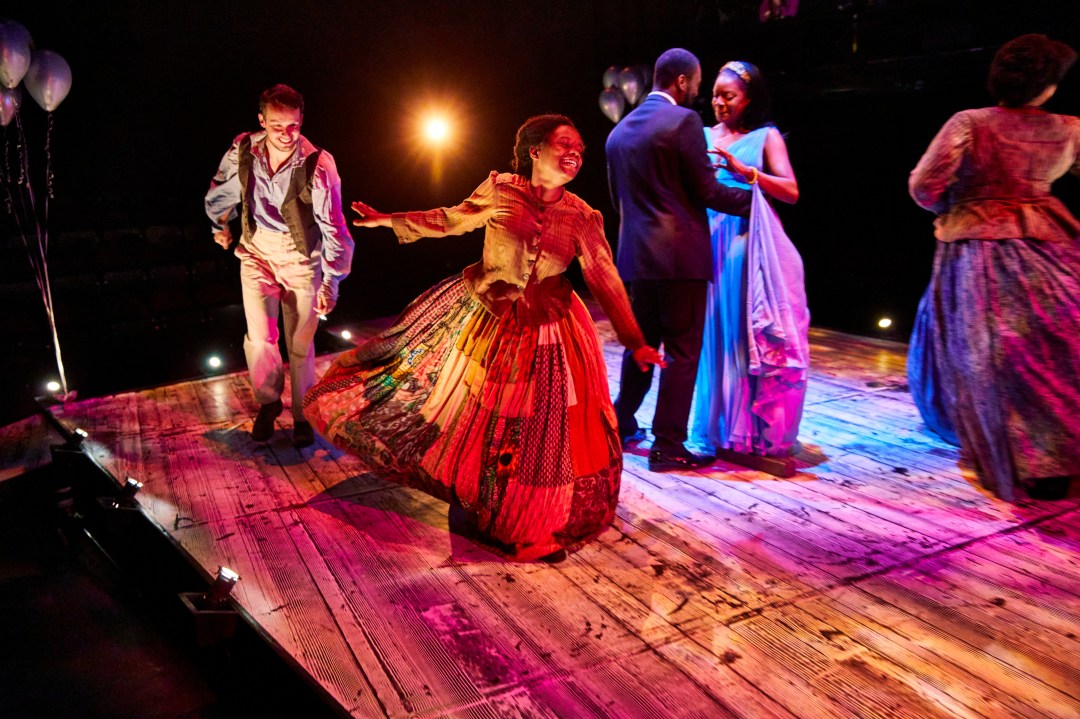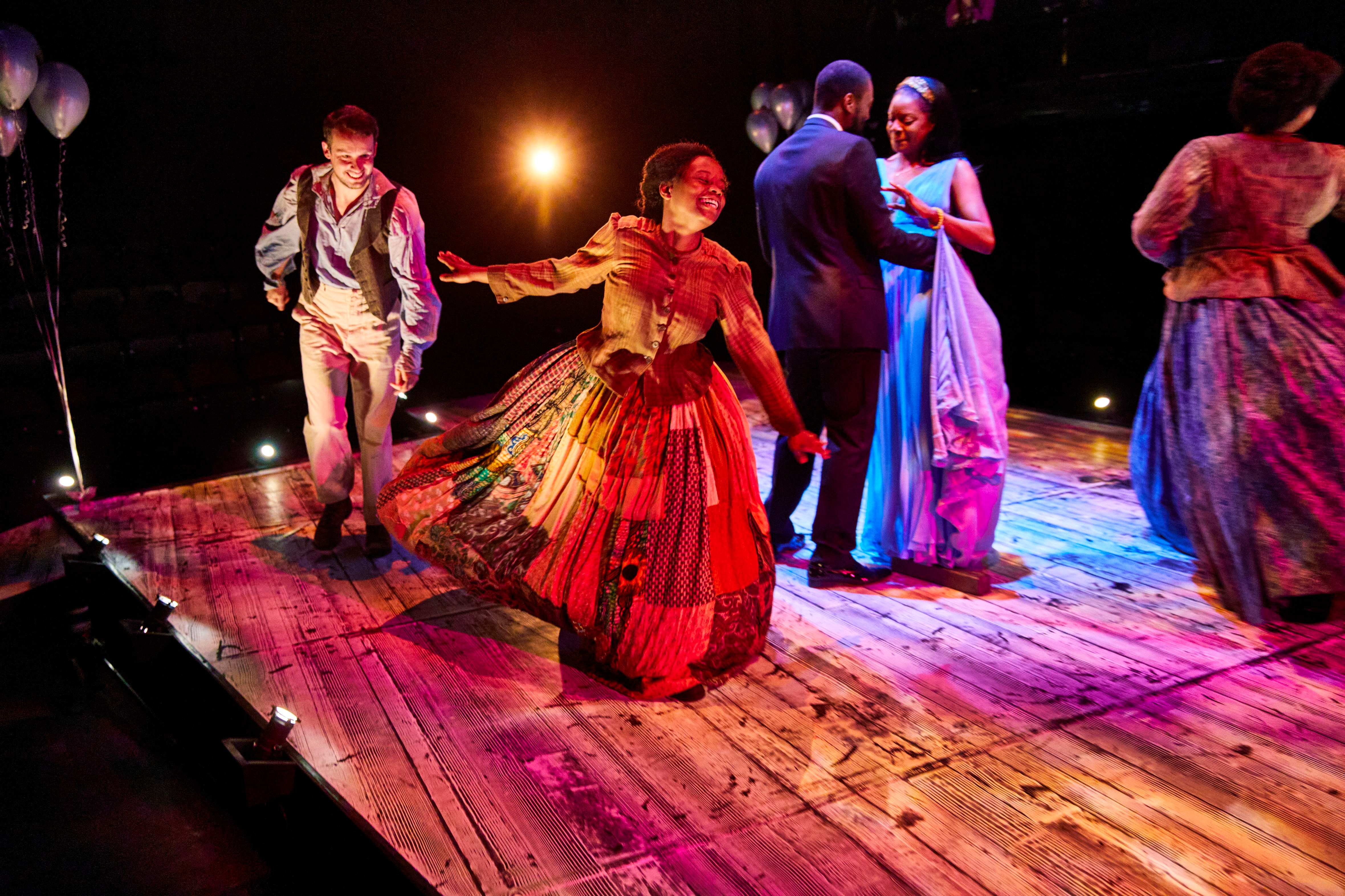Deep breath. Here goes. Winsome Pinnock’s new play about Turner opens with one of the most confusing and illogical scenes you’re ever likely to see. A teacher on a school trip is showing her pupils a Turner painting displayed in a gallery housed inside a ship donated by the producers of a film starring a famous actress, Lou, who happens to be on board wearing a sumptuous outfit for an awards ceremony, which she plans to avoid for fear that a coveted prize will be handed to a rival. Lou invites the school teacher to an after party that is scheduled to start when the awards ceremony ends. She then gets distracted by the sight of movement on the surface of the Turner canvas. The painted figures, frets Lou, appear to be shifting and jerking. Then she reveals that this is the very picture that drove John Ruskin mad. The scene ends with Lou wondering if she too is going crazy. Play-goers will ask themselves the same thing.
Scene two, by contrast, is relatively simple. It takes place in a studio where a new movie about Turner’s life is being filmed. Then the action scrolls back to the 19th century where we meet the real Turner as he bickers with a black female orphan who shares his home. Is that true? Turner’s housemate was a black Cockney? The playwright explains in the programme notes that she completed ‘a lot of research’ before writing the script so she deserves credit as a historical authority.
The scene ends with Lou wondering if she is going crazy. Play-goers will ask themselves the same thing
The next scene shows Turner, aged 65, disguising himself as a one-armed sketch-artist and stowing away on a slave ship where he thwarts a rebellion by hitting the chief mutineer over the head with a wooden bucket. Did that happen as well? Later we see Turner enjoying a chinwag with a mermaid in grey dreadlocks who claims to be his mother’s ghost. Confusingly, the ghost is played by the same actor (Cathy Tyson) who interpreted the role of his black house-mate. Leaving aside fictional silliness and convoluted plotting, the problem here is that the budget can’t meet the writer’s ambitions. The play has 24 characters and five interconnected storylines that cover a span of 200 years. But the director, Miranda Cromwell, has been given just ten actors to play with. More money was needed, or less script. Someone clearly lacked faith in the project.
A lot of scenes end inconclusively with a song or a dance, or with an intervention from the spirit world. This gives the narrative a lazy and haphazard texture. And the script is full of footnotes from the thought-police. Lou describes Britain as an ‘abolitionist theme park’ by which she means that our culture is saturated with reminders of the 1807 law that banned the slave trade throughout the empire. According to Lou it’s time to pipe down about all that liberty stuff.
The movie concerning Turner’s life includes a scene in which an African slave girl is whipped by an English sailor but we’re advised to mistrust this tableau because ‘it sends a subliminal message that the white man has never been a slave’. What a puzzling argument: any historic re-enactment of white-on-black violence is bound to make white people feel superior and should therefore be discouraged.
Another of the writer’s injunctions is delivered by the ghost of Lou’s grandfather who challenges the value of equality legislation. ‘Their laws say that we are “like” them but “like” means “not the same”,’ he argues. So equality is a weapon devised by white people to oppress their black neighbours. Even the dance floor is included in the writer’s scheme of morality. A male character starts to sway to the sound of an off-stage melody. ‘Dancing,’ he explains, ‘is a physical expression of freedom.’ This tsunami of piffle will serve at least one sociopolitical function. If you don’t know how to think and you want to sound as if you do, here’s your starting point.
Don’t Send Flowers is an old-fashioned melodrama set in a therapist’s waiting room. The patients sit and chat to each other and their friendship blossoms into romance. It begins as an affair between shy Grace and cocky Louis but their love is blown off course by the arrival of sexy Joanne who has just six months to live. The characters are original, well drawn and easy to like. The dialogue and the acting are carried off with relaxed proficiency. And the unfolding story is a delight to watch.
One question though: where is this heading? It hasn’t enough dramatic oomph for a West End transfer and it’s not sufficiently distinctive to spawn a TV series. It needs a star to save it from oblivion.
The company features an ‘intimacy co-ordinator’ who supervises the scenes in which characters kiss. It seems that another innocuous aspect of the performing arts is being colonised by panic-mongers: the smacker!








Comments